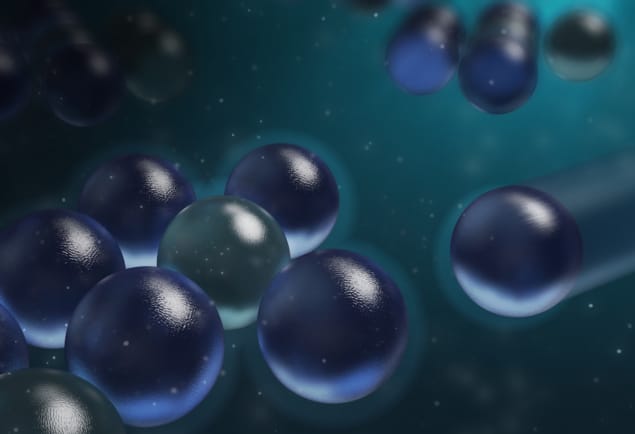
From a young age, we are taught in school that like charges – whether both positive or both negative – will repel each other, while opposite charges attract. It turns out that under certain conditions, like charges can actually attract each other instead. In work recently published in Nature Nanotechnology, researchers at the University of Oxford have demonstrated the attraction of like-charged particles in solutions.
The journey began for the lead scientist Madhavi Krishnan back in the mid-2000s, when she came across the “like-charge attraction problem” while studying how DNA molecules squeezed into slit-like boxes. It was expected that the DNA would flatten into a pancake-like geometry, but instead it aligned alongside the edge of the box. Without any external forces being applied, the only explanation was that the DNA was attracted to the box, despite them both being negatively charged. Thus, an interest in how attraction and repulsion may not be as they seem was born.
The like-charge problem is not new knowledge though. Different scientists over the years have tried to explain how like charges can attract, with some of the earliest works coming from Irving Langmuir back in the 1930s.
One of the areas where like-charge attraction is seen the most is within fluids, and the interaction of solid matter with fluids. “I encountered the problem early in my trajectory as a scientist,” Krishnan tells Physics World. “Considering the observations entailed such a fundamental departure from the current understanding of a basic and central phenomenon in the fluid phase, turning away from the problem was never going to be an option.”
The attraction of like charges in fluids has been seen many times using multivalent ions, but these are known ionic species that are exempt from DLVO (Derjaguin–Landau–Verwey–Overbeek) theory – the expectation that like-charged molecules will repel at long ranges when van der Waals forces are too weak to influence the interactions between molecules.
However, a number of molecules that are expected to follow the rules of DLVO theory – such as nucleic acids, liposomes, polymers and colloidal particles in aqueous media – have been shown to possess some level of attraction when like charges are present.
Why do some like charges attract?
Current theories of charge attraction within solvents consider the fluid to be a continuum but overlook some of the finer details of the solvent and how it interacts with solid interfaces. However, new theories suggest that the behaviour of the solvent at an interface has a significant influence on the total interaction free energy of two charge-carrying objects when they approach each other.
The latest study from Krishnan and colleagues showed that the solvent plays an unforeseen but crucial role in interparticle interactions and can break the charge reversal symmetry. The team also found that the degree of interparticle interactions that the solvent is responsible for depends strongly on the pH of the solution.
The researchers used bright-field microscopy to examine a range of solid particles, including inorganic silica, polymeric particles, and polyelectrolyte- and polypeptide-coated surfaces, within various solvents. They found that in an aqueous solution, negatively charged particles attracted each other and formed clusters, while positively charged particles repelled. However, in solvents that have an inverted dipole at an interface – such as alcohols – the opposite was true: positively charged particles attracted each other and negatively charged particles repelled.
“The findings would suggest a major re-calibration of basic principles that we believe govern the interaction of molecules and particles, and that we encounter at an early stage in our schooling and education,” says Krishnan. “The study brings to light an adjustment required of something we regard as a ‘textbook principle’.”
The reason for the like charges attracting each other is attributed to the solvent having a large influence on the interparticle interactions, which can spontaneously assemble the like-charged particles in the solution. This is because the concerted action of electrical charge at the interface and the local interfacial solvation structure generate an “electrosolvation force” between the negatively charged functional groups in the solution, causing the particles to attract each other and cluster.

Sliding water droplets surprise scientists
The team also found that both the sign and magnitude of the free energy contribution can have an impact on whether the particles form self-assembled systems (a negative free energy will drive spontaneity and self-assembly). It’s thought that these like-charge attractions are responsible for nanometre-scale biological processes, such as biomolecular folding of macromolecules in the body.
When asked about the impact of the study, Krishnan says that “the major open frontier is how this interaction affects biology. Biology is loaded with charge. These forces are the bedrock on which interactions between molecules plays out, influencing the way they come together, are packaged into small spaces, and ultimately carry out their function.”
“These are the most exciting directions, and I hope for us to be able to pursue at least some interesting questions in the general area,” Krishnan adds.
- SEO Powered Content & PR Distribution. Get Amplified Today.
- PlatoData.Network Vertical Generative Ai. Empower Yourself. Access Here.
- PlatoAiStream. Web3 Intelligence. Knowledge Amplified. Access Here.
- PlatoESG. Carbon, CleanTech, Energy, Environment, Solar, Waste Management. Access Here.
- PlatoHealth. Biotech and Clinical Trials Intelligence. Access Here.
- Source: https://physicsworld.com/a/scientists-discover-that-like-charged-particles-can-sometimes-attract/



